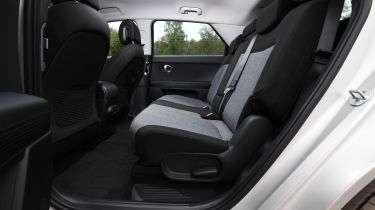Hyundai Ioniq 5 review: boot space, seating & practicality
The Ioniq 5's dedicated electric-car platform means little gets in the way of extensive interior space – for front and rear-seat passengers, and their luggage in the booth
| Length | Width | Height | Boot volume (seats up/down) |
|---|---|---|---|
| 4,635mm | 2,152mm | 1,605mm | 527/1,587 litres |
Short overhangs at the front and rear mean that even though the Ioniq 5 is as long as a Volkswagen ID.4, it actually has a longer wheelbase than the Audi A8 executive saloon. And the fact that it sits on a platform developed specifically for electric cars – unlike its Hyundai Kona Electric and Hyundai Ioniq Electric predecessors – means there's a huge amount of interior space for both front and rear passengers, with no transmission tunnel interrupting the flat floor.
Hyundai Ioniq 5 interior space, storage & comfort
Opening the Ioniq 5's huge rear doors reveals a vast interior, a flat floor and a limousine-esque amount of rear legroom. Unlike some luxury saloons, however, the Hyundai feels bright and spacious thanks to large windows and an open-plan design. It's comfortable, too, with squishy yet supportive seats all round.
As an extra-cost option on the range-topping Ultimate version, the front seats can fold almost completely flat; we’re not entirely sure why – maybe Hyundai thinks you could do with a power nap while the car is charging? The rear seats, meanwhile, can slide back and forth to either increase legroom or boot space as required.
Boot space
Speaking of boot space, there’s an impressive 527 litres on offer with all of the Ioniq 5's seats in place. That's a good deal more than the 402 litres on offer in the Ford Mustang Mach-E and just short of the Tesla Model 3's 542 litres – although the Ioniq 5's hatchback boot opening is more practical than the Tesla's saloon bootlid. Drop the Hyundai's rear seats down and a total of 1,587 litres is freed up for carrying larger or awkwardly shaped items.




